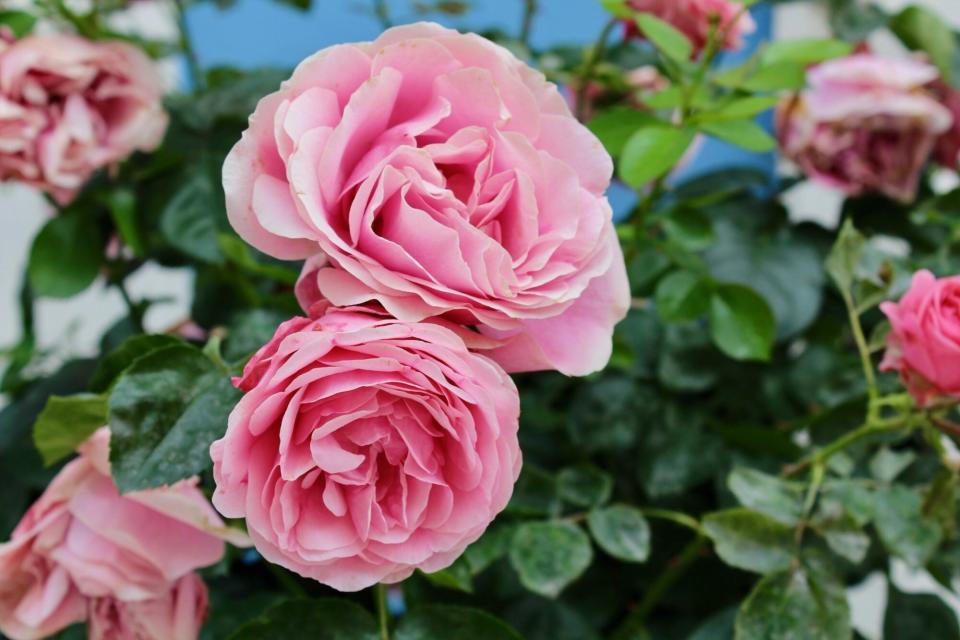Your Complete Guide to Fertilizing Roses for Vibrant, Beautiful Blooms
Roses are one of the most popular flowers in the world—the fragrant, multi-petaled beauties come in a variety of shades and sizes, making them perfect for just about any celebration or centerpiece arrangement. Despite their popularity, roses have a reputation for being hard to manage; they're heavy feeders, meaning they require a significant amount of nutrients and frequent fertilization. "The three main nutrients roses need from fertilizer are nitrogen, phosphorus, and potassium," says Kristen Smith, plants coordinator and rose product manager at Star® Roses and Plants. She also notes that roses require a range of micronutrients, including iron, calcium, and magnesium. When given a fertilizer with the necessary elements, the flowering shrub is actually quite easy to care for and will produce big, beautiful blooms year after year.
Related: The Best Fertilizers for Indoor and Outdoor Plants

Clement Perez / EyeEm / Getty Images
There are a few types of rose fertilizer.
In addition to containing the aforementioned key nutrients and micronutrients, rose fertilizer should have a pH of about six to seven, Smith says. "A pH outside of this ideal range will make it more difficult for the rose to absorb certain nutrients, even if the soil is nutrient rich," she adds. You'll also find a few different iterations when you shop, since rose fertilizer comes in several forms. There's liquid fertilizer, which is often used in the first year (it is less likely to burn new roots), explains Jimmy Speas, president of the Winston-Salem Rose Society; this also comes in handy during times of drought or summer when the heat can warm the soil or plants quickly. Liquid fertilizer may be applied as frequently as every two weeks during the growing season, but be sure to follow the manufacturer's guidelines for quantity and frequency. Beyond liquid, Smith says there's also granular, or slow-release food, which may be added once early in the season and will continuously release fertilizer into the soil over a longer period of time.
You'll find organic and non-organic options.
Both liquid and granular fertilizers come in organic and non-organic formulas. "Organic fertilizer is from naturally derived sources such as manure, fish emulsion, bone meal, or compost," Smith says. "Inorganic fertilizer is man-made from synthetic chemicals." Although each one contains the necessary nutrients that roses need to bloom, Speas is a fan of organic options. "Organics feed microorganisms that enable the roses to use the nutrients in the soil for food," he explains. This in turn enhances the bloom color and reduces the risk of root and leaf burn. Synthetic options, on the other hand, are typically offered at a lower price point and require less frequent application; they're more concentrated than organic offerings. To avoid root burn, it's best to add non-organic fertilizers to damp, rather than dry soil—but follow the manufacturer's label for step-by-step instructions.
Get your soil tested.
Many companies offer rose fertilizer that comes in a 10-10-10 ratio of nitrogen, phosphorus, and potassium, Speas explains. However, he recommends getting your soil tested before deciding on a formula. Doing so will let you know if your soil needs more or less of a required nutrient. "If a soil test says your nitrogen level is good but your phosphorus and potassium can use more, there is 5-10-10 or 10-20-20, which means nitrogen is half the amount as the other two," he says. Speas also notes that if you can't find a rose fertilizer with the specific percentage your soil needs, find one that lists the other nutrients at a lower concentration than the one you need.
Here's how and when to fertilize roses.
When it comes to fertilizing roses, Speas says growers should "focus on what's going on under the ground more than what's going on above it," noting that forming a strong root system is key to a successful bloom. Newly-planted bushes need fertilizer that's high in phosphorus, which promotes root growth, more than they need nitrogen-rich food. Established roses won't need to be fertilized until early spring as they begin to leaf out—wait until you see about six inches of new growth to begin. If the roses are very dry, water them first before feeding them; Smith says this will prevent the flower from taking nutrients up too quickly. Fertilize the perennial regularly throughout its growing season (about every two to four weeks depending on the type of fertilizer used). Stop feeding your roses in late summer when they begin preparing for winter dormancy. "Fertilizing late in the season may encourage unnecessary tender new growth which may get damaged by cold snaps in the fall," Smith explains. "This damaged growth may then be susceptible to further damage by pests." You can, however, add organics like compost or rotted manure as fertilizer during winter when the roses are dormant.
Our top fertilizer picks.
There are plenty of rose fertilizers to choose from, but to help you cut through the noise, asked our experts to share their favorites. Speas says many growers use Mills Magic ($29.99, millsmix.com). The 100-percent natural product was formulated by Ted Mills, an accredited consulting rosarian and rose show judge of the American Rose Society. The mix features a combination of alfalfa meal, blood meal, fermented citrus rinds, cottonseed meal, feather meal, bone meal, and sulfate of potash-magnesia. Another great option is Down to Earth Organic Rose and Flower Fertilizer ($17.84, amazon.com). The special blend is derived from natural ingredients and provides roses with all three-essential nutrients, as well as trace elements for healthy plant stock. For a liquid fertilizer, we recommend Neptune's Harvest Fish Fertilizer ($38.18, amazon.com). It contains all the macronutrients naturally found in fish and is made by a process that protects the vitamins, amino acids, enzymes, and growth hormones necessary for developing beautiful blooms.

